
Illustrative Math Alignment: Grade 7 Unit 9
Putting it All Together
Lesson 9: Measurement Error (Part 2)
Use the following Media4Math resources with this Illustrative Math lesson.
| Thumbnail Image | Title | Body | Curriculum Topic |
|---|---|---|---|

|
Math Example--Percents--Percent Change--Example 6 | Math Example--Percents--Percent Change--Example 6
This is part of a collection of math examples that focus on percents. |
Percents |
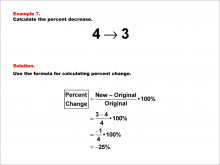
|
Math Example--Percents--Percent Change--Example 7 | Math Example--Percents--Percent Change--Example 7
This is part of a collection of math examples that focus on percents. |
Percents |
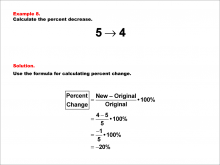
|
Math Example--Percents--Percent Change--Example 8 | Math Example--Percents--Percent Change--Example 8
This is part of a collection of math examples that focus on percents. |
Percents |

|
Math Example--Percents--Percent Change--Example 9 | Math Example--Percents--Percent Change--Example 9
This is part of a collection of math examples that focus on percents. |
Percents |
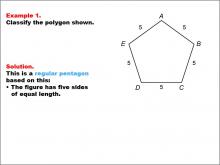
|
Math Example--Polygons--Polygon Classification: Example 1 | Math Example--Polygons--Polygon Classification: Example 1TopicPolygons DescriptionThis example showcases a pentagon with all sides labeled as 5. It demonstrates a regular pentagon, characterized by five sides of equal length. This visual representation helps students understand the concept of regular polygons and their defining characteristics. The topic of polygon classification is crucial in geometry. This collection of examples provides a comprehensive look at various types of pentagons, both regular and irregular. By examining different configurations of sides and angles, students can develop a deeper understanding of polygon properties and classification criteria. |
Definition of a Polygon |
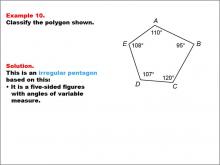
|
Math Example--Polygons--Polygon Classification: Example 10 | Math Example--Polygons--Polygon Classification: Example 10TopicPolygons DescriptionThis example showcases a pentagon labeled with vertices A, B, C, D, E, where the angles are marked as 110°, 95°, 120°, 107°, and 108°. It demonstrates an irregular pentagon based on the variation in angle measures, highlighting that regularity depends on both side lengths and angle measures. Understanding polygon classification is essential in geometry as it helps students recognize and categorize shapes based on their properties. This collection of examples emphasizes the importance of both side lengths and angle measures in determining the regularity of pentagons. |
Definition of a Polygon |
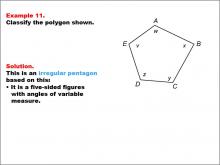
|
Math Example--Polygons--Polygon Classification: Example 11 | Math Example--Polygons--Polygon Classification: Example 11TopicPolygons DescriptionThis example presents a pentagon labeled with vertices A, B, C, D, E, where the sides are marked with variables w, x, y, z, and v. It illustrates an irregular pentagon by using different variables to represent potentially different side lengths, emphasizing that side length variation results in irregularity. Polygon classification is a fundamental concept in geometry that helps students analyze and categorize shapes based on their properties. This collection of examples provides a comprehensive look at various types of pentagons, highlighting the importance of side length equality in determining regularity. |
Definition of a Polygon |
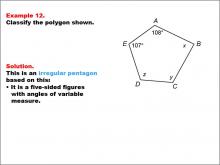
|
Math Example--Polygons--Polygon Classification: Example 12 | Math Example--Polygons--Polygon Classification: Example 12TopicPolygons DescriptionThis example features a pentagon labeled with vertices A, B, C, D, E, where the angles are marked as 108°, x, y, z, and 107°. It demonstrates an irregular pentagon based on the variation in angle measures, highlighting that regularity depends on all angles being equal. Understanding polygon classification is essential in geometry as it helps students recognize and categorize shapes based on their properties. This collection of examples emphasizes the importance of angle measures in determining the regularity of pentagons, showing that even one different angle makes the polygon irregular. |
Definition of a Polygon |
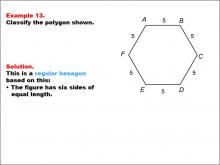
|
Math Example--Polygons--Polygon Classification: Example 13 | Math Example--Polygons--Polygon Classification: Example 13TopicPolygons DescriptionThis example showcases a hexagon with all sides labeled as 5, indicating equal length. It demonstrates a regular hexagon, characterized by six sides of equal length. This visual representation helps students understand the concept of regular polygons and their defining characteristics. The topic of polygon classification is crucial in geometry. This collection of examples provides a comprehensive look at various types of hexagons, both regular and irregular. By examining different configurations of sides and angles, students can develop a deeper understanding of polygon properties and classification criteria. |
Definition of a Polygon |
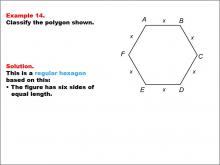
|
Math Example--Polygons--Polygon Classification: Example 14 | Math Example--Polygons--Polygon Classification: Example 14TopicPolygons DescriptionThis example presents a hexagon with all sides labeled as x, indicating equal length. It illustrates another instance of a regular hexagon, reinforcing the concept that a regular polygon has all sides of equal length, even when represented by a variable. Polygon classification is a fundamental topic in geometry that helps students understand the properties and characteristics of different shapes. This collection of examples provides a comprehensive overview of various hexagon types, allowing students to distinguish between regular and irregular polygons based on their side lengths and angle measures. |
Definition of a Polygon |
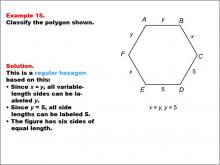
|
Math Example--Polygons--Polygon Classification: Example 15 | Math Example--Polygons--Polygon Classification: Example 15TopicPolygons DescriptionThis example features a hexagon with sides labeled y, x, and 5, showing that x = y = 5, making all sides equal in length. It demonstrates a regular hexagon by using a combination of variables and numeric values to represent equal side lengths. Understanding polygon classification is crucial in geometry as it helps students recognize and categorize shapes based on their properties. This collection of examples highlights different ways to represent regular hexagons, emphasizing the importance of side length equality in classification. |
Definition of a Polygon |
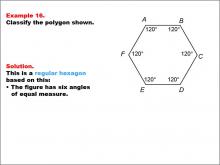
|
Math Example--Polygons--Polygon Classification: Example 16 | Math Example--Polygons--Polygon Classification: Example 16TopicPolygons DescriptionThis example showcases a hexagon with all interior angles labeled as 120 degrees, indicating equal angles. It demonstrates that a regular hexagon can be identified not only by equal side lengths but also by equal angle measures, reinforcing the dual criteria for regularity in polygons. Polygon classification is a fundamental concept in geometry that helps students analyze and categorize shapes based on their properties. This collection of examples provides a comprehensive look at various aspects of regular hexagons, emphasizing both side length and angle measure as defining characteristics. |
Definition of a Polygon |
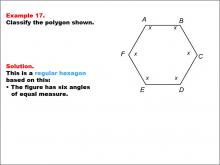
|
Math Example--Polygons--Polygon Classification: Example 17 | Math Example--Polygons--Polygon Classification: Example 17TopicPolygons DescriptionThis example presents a hexagon with six equal sides labeled as x and equal angles, indicating a regular hexagon. It reinforces the concept of a regular polygon by visually representing both the equality of all sides and angles. Understanding polygon classification is essential in geometry as it helps students recognize and categorize shapes based on their properties. This collection of examples provides various representations of regular hexagons, emphasizing the importance of both side length and angle measure equality in classification. |
Definition of a Polygon |
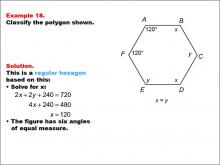
|
Math Example--Polygons--Polygon Classification: Example 18 | Math Example--Polygons--Polygon Classification: Example 18TopicPolygons DescriptionThis example features a hexagon with two angles labeled as 120 degrees and sides labeled x and y, where x = y. It demonstrates how to determine if a hexagon is regular by solving for the unknown angle measures and confirming equal side lengths. Polygon classification is a crucial topic in geometry that helps students distinguish between regular and irregular shapes. This collection of examples provides a comprehensive look at various types of hexagons, highlighting the importance of both angle measures and side lengths in determining regularity. |
Definition of a Polygon |

|
Math Example--Polygons--Polygon Classification: Example 19 | Math Example--Polygons--Polygon Classification: Example 19TopicPolygons DescriptionThis example showcases a hexagon with sides labeled with varying lengths: AB = 6, BC = 4, CD = 6, DE = 3, EF = 6, and FA = 5. It demonstrates an irregular hexagon, emphasizing that side length variation results in irregularity. Understanding polygon classification is crucial in geometry as it helps students recognize and categorize shapes based on their properties. This collection of examples highlights the differences between regular and irregular hexagons, focusing on side length as a key determining factor. |
Definition of a Polygon |
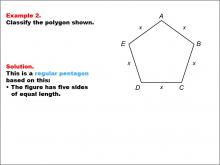
|
Math Example--Polygons--Polygon Classification: Example 2 | Math Example--Polygons--Polygon Classification: Example 2TopicPolygons DescriptionThis example presents a pentagon with all sides labeled as x, indicating equal length. It illustrates another instance of a regular pentagon, reinforcing the concept that a regular polygon has all sides of equal length. Polygon classification is a fundamental topic in geometry that helps students understand the properties and characteristics of different shapes. This collection of examples provides a comprehensive overview of various pentagon types, allowing students to distinguish between regular and irregular polygons based on their side lengths and angle measures. |
Definition of a Polygon |
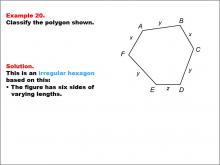
|
Math Example--Polygons--Polygon Classification: Example 20 | Math Example--Polygons--Polygon Classification: Example 20TopicPolygons DescriptionThis example presents a hexagon with sides labeled as x, y, and z, indicating varying lengths. It illustrates another case of an irregular hexagon, demonstrating that the presence of different variables for side lengths suggests irregularity. Polygon classification is a fundamental concept in geometry that helps students analyze and categorize shapes based on their properties. This collection of examples provides a comprehensive look at various types of hexagons, emphasizing the importance of side length equality in determining regularity. |
Definition of a Polygon |
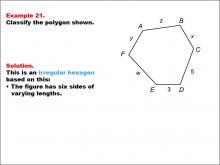
|
Math Example--Polygons--Polygon Classification: Example 21 | Math Example--Polygons--Polygon Classification: Example 21
This is part of a collection of math examples that focus on geometric shapes. |
Definition of a Polygon |

|
Math Example--Polygons--Polygon Classification: Example 22 | Math Example--Polygons--Polygon Classification: Example 22
This is part of a collection of math examples that focus on geometric shapes. |
Definition of a Polygon |

|
Math Example--Polygons--Polygon Classification: Example 23 | Math Example--Polygons--Polygon Classification: Example 23
This is part of a collection of math examples that focus on geometric shapes. |
Definition of a Polygon |
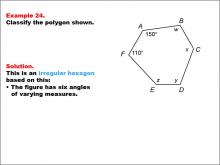
|
Math Example--Polygons--Polygon Classification: Example 24 | Math Example--Polygons--Polygon Classification: Example 24
This is part of a collection of math examples that focus on geometric shapes. |
Definition of a Polygon |
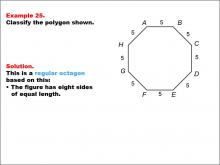
|
Math Example--Polygons--Polygon Classification: Example 25 | Math Example--Polygons--Polygon Classification: Example 25TopicPolygons DescriptionThis example showcases an octagon with all sides labeled as 5, indicating equal length. It demonstrates a regular octagon, characterized by eight sides of equal length. This visual representation helps students understand the concept of regular polygons and their defining characteristics. The topic of polygon classification is crucial in geometry. This collection of examples provides a comprehensive look at various types of octagons, both regular and irregular. By examining different configurations of sides and angles, students can develop a deeper understanding of polygon properties and classification criteria. |
Definition of a Polygon |
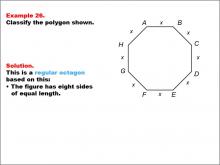
|
Math Example--Polygons--Polygon Classification: Example 26 | Math Example--Polygons--Polygon Classification: Example 26TopicPolygons DescriptionThis example presents an octagon with all sides labeled as x, indicating equal length. It illustrates another instance of a regular octagon, reinforcing the concept that a regular polygon has all sides of equal length, even when represented by a variable. Understanding polygon classification is essential in geometry as it helps students recognize and categorize shapes based on their properties. This collection of examples provides various representations of regular octagons, emphasizing the importance of side length equality in classification. |
Definition of a Polygon |

|
Math Example--Polygons--Polygon Classification: Example 27 | Math Example--Polygons--Polygon Classification: Example 27TopicPolygons DescriptionThis example features an octagon with sides labeled as x, z, and 5, showing that x = z = 5, indicating equal length for all sides. It demonstrates a regular octagon by using a combination of variables and numeric values to represent equal side lengths. Polygon classification is a fundamental concept in geometry that helps students analyze and categorize shapes based on their properties. This collection of examples provides a comprehensive look at various aspects of regular octagons, emphasizing the importance of side length equality in classification. |
Definition of a Polygon |
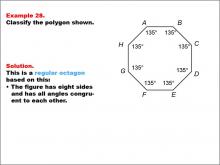
|
Math Example--Polygons--Polygon Classification: Example 28 | Math Example--Polygons--Polygon Classification: Example 28TopicPolygons DescriptionThis example showcases an octagon with all angles labeled as 135 degrees, indicating congruent angles. It demonstrates that a regular octagon can be identified not only by equal side lengths but also by equal angle measures, reinforcing the dual criteria for regularity in polygons. Understanding polygon classification is crucial in geometry as it helps students recognize and categorize shapes based on their properties. This collection of examples highlights different aspects of regular octagons, emphasizing both side length and angle measure as defining characteristics. |
Definition of a Polygon |
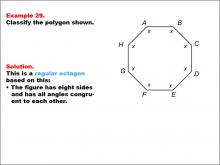
|
Math Example--Polygons--Polygon Classification: Example 29 | Math Example--Polygons--Polygon Classification: Example 29TopicPolygons DescriptionThis example presents an octagon with all angles labeled as "x," indicating a regular polygon. It illustrates a regular octagon by visually representing the equality of all angles using a single variable. This reinforces the concept that a regular polygon has all angles of equal measure. Polygon classification is a fundamental concept in geometry that helps students analyze and categorize shapes based on their properties. This collection of examples provides a comprehensive look at various aspects of regular octagons, emphasizing the importance of side length equality in classification. |
Definition of a Polygon |
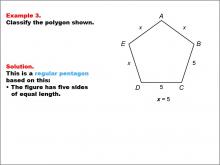
|
Math Example--Polygons--Polygon Classification: Example 3 | Math Example--Polygons--Polygon Classification: Example 3TopicPolygons DescriptionThis example features a pentagon with sides labeled x and two sides labeled as 5, with x = 5, demonstrating that all sides are equal. It reinforces the concept of a regular pentagon by showing how different notations can represent the same length. The study of polygon classification helps students develop critical thinking skills in geometry. This collection of examples illustrates various ways to represent and identify regular pentagons, emphasizing the importance of side length equality in classification. |
Definition of a Polygon |

|
Math Example--Polygons--Polygon Classification: Example 30 | Math Example--Polygons--Polygon Classification: Example 30TopicPolygons DescriptionThis example features an octagon with angles labeled as 135° and angles labeled as "u" and "x." It demonstrates how to determine if an octagon is regular by solving for the unknown angle measures and confirming equal side lengths. Understanding polygon classification is essential in geometry as it helps students recognize and categorize shapes based on their properties. This collection of examples provides insights into how partial information about angle measures and side lengths can be used to determine the regularity of octagons. |
Definition of a Polygon |
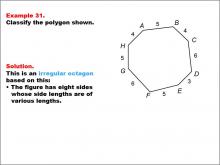
|
Math Example--Polygons--Polygon Classification: Example 31 | Math Example--Polygons--Polygon Classification: Example 31TopicPolygons DescriptionThis example showcases an irregular octagon with sides of varying lengths labeled as 4, 5, 6, and 3. It demonstrates that not all eight-sided figures are regular, emphasizing the importance of equal side lengths in the classification of regular polygons. Polygon classification is a crucial topic in geometry that helps students distinguish between regular and irregular shapes. This collection of examples provides a comprehensive look at various types of octagons, highlighting the differences between regular and irregular polygons based on side lengths. |
Definition of a Polygon |

|
Math Example--Polygons--Polygon Classification: Example 32 | Math Example--Polygons--Polygon Classification: Example 32TopicPolygons DescriptionThis example presents an irregular octagon with sides labeled as w, x, y, z, and u, indicating varying lengths. It illustrates another case of an irregular octagon, demonstrating that the presence of different variables for side lengths suggests irregularity. Understanding polygon classification is crucial in geometry as it helps students recognize and categorize shapes based on their properties. This collection of examples highlights the importance of considering side lengths when determining the regularity of octagons. |
Definition of a Polygon |
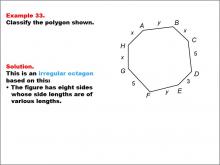
|
Math Example--Polygons--Polygon Classification: Example 33 | Math Example--Polygons--Polygon Classification: Example 33TopicPolygons DescriptionThis example features an octagon with sides labeled as x, y, 5, and 3. The sides are of varying lengths, indicating it is irregular. It demonstrates how a combination of variables and specific numeric values can be used to show irregularity in polygons. Polygon classification is a fundamental concept in geometry that helps students analyze and categorize shapes based on their properties. This collection of examples provides insights into how partial information about side lengths can be used to determine the irregularity of octagons. |
Definition of a Polygon |
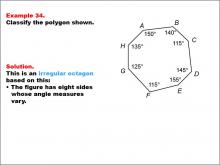
|
Math Example--Polygons--Polygon Classification: Example 34 | Math Example--Polygons--Polygon Classification: Example 34TopicPolygons DescriptionThis example showcases an octagon with angles labeled as 150°, 140°, 115°, 145°, 155°, 115°, 125°, and 135°. The angles vary, indicating it is irregular. It demonstrates that irregularity in polygons can be determined by examining angle measures alone. Understanding polygon classification is essential in geometry as it helps students recognize and categorize shapes based on their properties. This collection of examples highlights the importance of angle measures in determining the regularity of octagons, showing that even if side lengths are not given, angle information can be sufficient for classification. |
Definition of a Polygon |
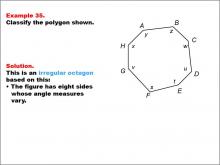
|
Math Example--Polygons--Polygon Classification: Example 35 | Math Example--Polygons--Polygon Classification: Example 35TopicPolygons DescriptionThis example presents an octagon with sides labeled as x, y, z, w, u, t, s, and v. The sides are of varying lengths and angles, indicating it is irregular. It illustrates how using different variables for both side lengths and angles can suggest irregularity in a polygon. Polygon classification is a crucial topic in geometry that helps students distinguish between regular and irregular shapes. This collection of examples provides a comprehensive look at various types of octagons, highlighting the importance of considering both side lengths and angle measures in determining regularity. |
Definition of a Polygon |
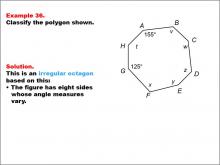
|
Math Example--Polygons--Polygon Classification: Example 36 | Math Example--Polygons--Polygon Classification: Example 36TopicPolygons DescriptionThis example features an octagon with angles labeled as 155° and 125°, and other angles labeled with variables t, v, w, x, y, and z. The angles vary, indicating it is irregular. It demonstrates how a combination of specific angle measures and variables can be used to show irregularity in polygons. Understanding polygon classification is essential in geometry as it helps students recognize and categorize shapes based on their properties. This collection of examples highlights the importance of angle measures in determining the regularity of octagons, showing that even partial information can be sufficient for classification. |
Definition of a Polygon |
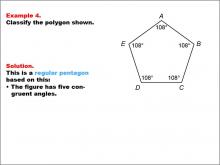
|
Math Example--Polygons--Polygon Classification: Example 4 | Math Example--Polygons--Polygon Classification: Example 4TopicPolygons DescriptionThis example showcases a pentagon with each angle labeled as 108 degrees, indicating congruent angles. It demonstrates that a regular pentagon can be identified not only by equal side lengths but also by equal angle measures. Understanding polygon classification is crucial in geometry as it helps students recognize and categorize shapes based on their properties. This collection of examples highlights different aspects of regular pentagons, emphasizing both side length and angle measure as defining characteristics. |
Definition of a Polygon |
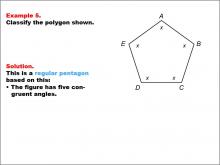
|
Math Example--Polygons--Polygon Classification: Example 5 | Math Example--Polygons--Polygon Classification: Example 5TopicPolygons DescriptionThis example presents a pentagon labeled with vertices A, B, C, D, and E, with each side marked with an "x" to indicate equal length. It reinforces the concept of a regular pentagon by visually representing the equality of all sides. Polygon classification is a fundamental topic in geometry that helps students understand the properties and relationships of different shapes. This collection of examples provides various representations of regular pentagons, emphasizing the importance of side length equality in classification. |
Definition of a Polygon |
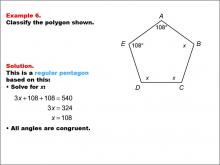
|
Math Example--Polygons--Polygon Classification: Example 6 | Math Example--Polygons--Polygon Classification: Example 6TopicPolygons DescriptionThis example features a pentagon labeled with vertices A, B, C, D, and E, where two angles are marked as 108 degrees, and the other angles are marked as "x". It demonstrates how to determine if a pentagon is regular by solving for the unknown angle measures. Understanding polygon classification is essential in geometry as it helps students analyze and categorize shapes based on their properties. This collection of examples highlights different aspects of regular pentagons, emphasizing both side length and angle measure as defining characteristics. |
Definition of a Polygon |
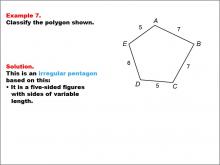
|
Math Example--Polygons--Polygon Classification: Example 7 | Math Example--Polygons--Polygon Classification: Example 7TopicPolygons DescriptionThis example showcases a pentagon labeled with vertices A, B, C, D, and E, where the sides have different lengths: 5, 7, 7, 5, and 6 units. It illustrates an irregular pentagon, demonstrating that not all five-sided figures are regular. Polygon classification is a crucial topic in geometry that helps students distinguish between regular and irregular shapes. This collection of examples provides a comprehensive look at various types of pentagons, highlighting the differences between regular and irregular polygons based on side lengths and angle measures. |
Definition of a Polygon |
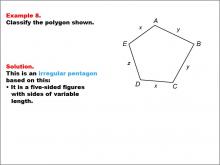
|
Math Example--Polygons--Polygon Classification: Example 8 | Math Example--Polygons--Polygon Classification: Example 8TopicPolygons DescriptionThis example presents a pentagon labeled with vertices A, B, C, D, and E, where the sides are marked with variables x, y, and z, indicating different lengths. It demonstrates another instance of an irregular pentagon, emphasizing that side length variation results in irregularity. Understanding polygon classification is crucial in geometry as it helps students recognize and categorize shapes based on their properties. This collection of examples highlights the differences between regular and irregular pentagons, focusing on side length as a key determining factor. |
Definition of a Polygon |

|
Math Example--Polygons--Polygon Classification: Example 9 | Math Example--Polygons--Polygon Classification: Example 9TopicPolygons DescriptionThis example features a pentagon labeled with vertices A, B, C, D, E, where the sides are labeled as y, z, 5, 4, and x. It illustrates another case of an irregular pentagon, demonstrating that the presence of different side lengths, including both numeric and variable representations, results in irregularity. Polygon classification is a fundamental concept in geometry that helps students analyze and categorize shapes based on their properties. This collection of examples provides a comprehensive look at various types of pentagons, emphasizing the importance of side length equality in determining regularity. |
Definition of a Polygon |
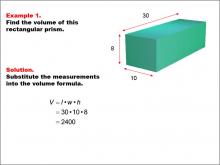
|
Math Example--Volume Concepts--Calculating Volume: Example 1 | Math Example--Volume Concepts--Calculating Volume: Example 1TopicVolume DescriptionA rectangular prism with dimensions labeled: length = 30, width = 10, and height = 8. The image shows how to find the volume of the prism using the formula for volume of a rectangular prism. This image illustrates Example 1: The caption explains how to calculate the volume of the rectangular prism using the formula V = l * w * h. The given dimensions are substituted into the formula: V = 30 * 10 * 8 = 2400.. |
Volume |
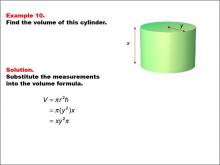
|
Math Example--Volume Concepts--Calculating Volume: Example 10 | Math Example--Volume Concepts--Calculating Volume: Example 10TopicVolume DescriptionA green cylinder with a general radius y and height x. The radius is marked on the top surface, and the height is marked on the side. This image illustrates Example 10: The task is to find the volume of this cylinder. The volume formula V = πr2h is used, and substituting r = y and h = x, the volume is calculated as V = xy2π. |
Volume |
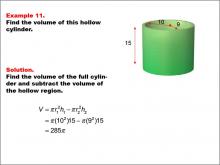
|
Math Example--Volume Concepts--Calculating Volume: Example 11 | Math Example--Volume Concepts--Calculating Volume: Example 11TopicVolume DescriptionA hollow green cylinder with an outer radius of 10 units, an inner radius of 9 units, and a height of 15 units. The radii are marked on the top surface, and the height is marked on the side. This image illustrates Example 11: The task is to find the volume of this hollow cylinder. The volume formula for a hollow cylinder V = πr12h1 - πr22h2 is used. Substituting values, the result is V = 285π. |
Volume |
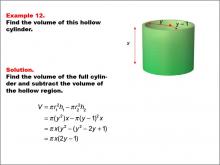
|
Math Example--Volume Concepts--Calculating Volume: Example 12 | Math Example--Volume Concepts--Calculating Volume: Example 12TopicVolume DescriptionA hollow green cylinder with an outer radius y, an inner radius y - 1, and a height x. The radii are marked on the top surface, and the height is marked on the side. This image illustrates Example 12: The task is to find the volume of this hollow cylinder. Using V = π(r12h1 - r22h2), substituting values gives: V = πx(y2 - (y - 1)2= πx(2y - 1). |
Volume |

|
Math Example--Volume Concepts--Calculating Volume: Example 13 | Math Example--Volume Concepts--Calculating Volume: Example 13TopicVolume DescriptionA rectangular-based pyramid is shown with dimensions: base length 10, base width 8, and height 30. The image demonstrates how to calculate the volume of this pyramid. This image illustrates Example 13: The caption provides a step-by-step solution for calculating the volume of a pyramid with a rectangular base using the formula V = (1/3) * Area of Base * h. Substituting values: V = (1/3) * 8 * 10 * 30 = 800. |
Volume |
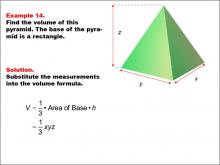
|
Math Example--Volume Concepts--Calculating Volume: Example 14 | Math Example--Volume Concepts--Calculating Volume: Example 14TopicVolume DescriptionA general rectangular-based pyramid is shown with variables x, y, and z representing the base dimensions and height. This example shows how to calculate the volume of a pyramid using variables instead of specific numbers. This image illustrates Example 14: The caption explains how to calculate the volume of a pyramid with a rectangular base using the formula V = (1/3) * Area of Base * h, which simplifies to V = (1/3) * x * y * z. |
Volume |

|
Math Example--Volume Concepts--Calculating Volume: Example 15 | Math Example--Volume Concepts--Calculating Volume: Example 15TopicVolume |
Volume |
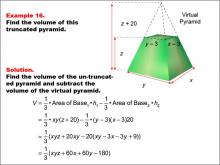
|
Math Example--Volume Concepts--Calculating Volume: Example 16 | Math Example--Volume Concepts--Calculating Volume: Example 16TopicVolume DescriptionA truncated rectangular-based pyramid is shown with variables x, y, and z representing dimensions. The smaller virtual pyramid has reduced dimensions by 3 units for both width and length and reduced height by z - 20. The image demonstrates how to calculate the volume in terms of variables. This image illustrates Example 16: The caption explains how to find the volume of a truncated pyramid using variables for both pyramids' dimensions. Formula: V = (1/3) * xy(z + 20) - (1/3) * (y - 3)(x - 3)(z), which simplifies to V = (1/3) * (xyz + 60x + 60y - 180). |
Volume |
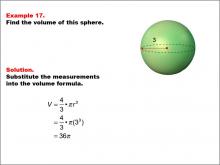
|
Math Example--Volume Concepts--Calculating Volume: Example 17 | Math Example--Volume Concepts--Calculating Volume: Example 17TopicVolume DescriptionA green sphere with a radius labeled as 3. The image is part of a math example showing how to calculate the volume of a sphere. This image illustrates Example 17: The text describes finding the volume of a sphere. The formula used is V = (4/3) * π * r3, where r = 3. After substituting, the result is V = 36π. Volume is a fundamental concept in geometry that helps students understand the space occupied by three-dimensional objects. In this collection, each example uses various geometric shapes to calculate volume, showcasing real-life applications of volume in different shapes. |
Volume |
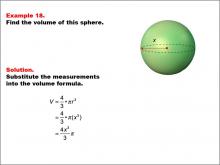
|
Math Example--Volume Concepts--Calculating Volume: Example 18 | Math Example--Volume Concepts--Calculating Volume: Example 18TopicVolume Description
A green sphere with a radius labeled as x. This image is part of a math example showing how to calculate the volume of a sphere using an unknown radius. This image illustrates Example 18: The text explains how to find the volume of a sphere with an unknown radius x. The formula used is V = (4/3) * π * r3, and substituting r = x gives V = (4/3) * x3 * π. |
Volume |